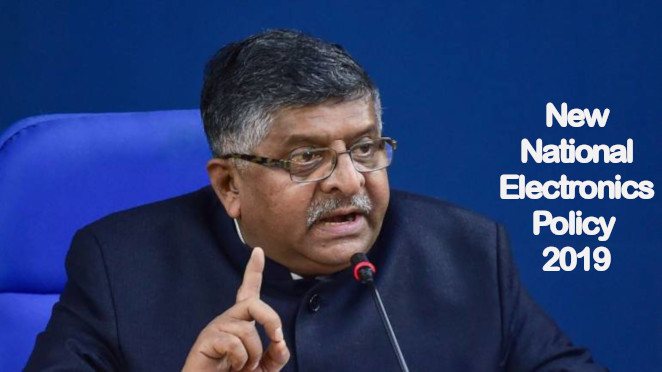
In News
The Union Cabinet has given its approval to the new National Electronics Policy 2019. The policy is a replacement to the National Electronics Policy of 2012.
Highlights New National Electronics Policy:-
- The policy was proposed by the Ministry of Electronics and Information Technology (MeitY).
- It envisages India to become the global hub of Electronics System Design and Manufacturing – (ESDM).
- It does this by creating an environment conducive for the electronics industry, increasing capabilities in the country including for developing chipsets.
- One of the key aims of the policy is the achievement of a turnover of $400 billion for the EDSM sector by 2025.
- The share of Indian electronics manufacturing in the world as of 2017-18 is 26.7%. With the policy, the government is aiming to increase it to 32%.
The Key Features of Govt. Approved NEP-2019:-
- Developing an ecosystem of EDSM in the country to promote domestic production of electronics and exporting them. This is through the new 2.0 version of Electronics Manufacturing Cluster Scheme.
- Under the scheme, support to a group of industries will be given for developing industries. Earlier, support was given to individual industry which did not bear results.
- Incentives and schemes to manufacture core electronic items within the country.
- For extremely high-tech electronics such as semiconductor fabrication, etc will get a special incentive package.
- Formulating schemes for developing new and existing units.
- Promoting R&D and innovation at the industry level in all sub-sectors of electronics.
- Promoting grass root level innovations and early stage Start-ups in technologies such as 5G, loT/ Sensors, Artificial Intelligence (Al), Machine Learning, Virtual Reality (VR), Drones, Robotics, Additive Manufacturing, Photonics, Nano-based devices, etc.
- Incentives for making skilled manpower available and for re-skilling of the workforce.
- Thrust areas – Power electronics for mobility and strategic electronics industry, medical devices industry, automotive industry, fabless chip design industry.
- Setting up of a Sovereign Patent Fund (SPF) to develop and acquire IPs in the sector. This will allow the Indian industries to get these patents at low costs.
- To improve national security profile, the policy envisages promoting electronic value chain initiatives.
- It proposes an interest subsidy on loans for plants and machinery up to Rs. 1000 crore to the tune of 4%.
- It also proposes to create a fund to support banks on plants and machinery loans of up to Rs. 100 crore. This is done through a default guarantee of 75%.
- Key Target – Production of 1 billion (100 crores) mobile handsets in the country by 2025.
- New NEP Policy & Interim Budget 2019 will create 1 Crore Jobs for people.
Importance of the National Electronics Policy:-
- India’s consumption of electronic goods is fast expanding. It is set to become the second largest market for smartphones after China beating the USA in the near future.
- But the problem is, India is importing around 50% of electronic goods for its needs. Be it the mobile devices, medical devices or high-end tech, we are importing heavily. In May 2018, the import bill for electronics was $57.8 billion. This is widening the country’s Current Account Deficit (CAD). If left unchecked it will reach $100 billion very quickly.
- In such a scenario, the new policy is definitely going to benefit the Indian industry.
- Already, many startups have ventured into electronic manufacturing that too using the most advanced technologies.
- One of the key areas where India is lacking is in the fabrication of semiconductors. The previous policy tried to address this but nothing fruitful came out. Hope the new policy will fill this critical gap.
- An interesting aspect of the policy is the Sovereign Patent Fund (SPF). Many small scale enterprises are unable to buy costly patents and lose out to big corporations. With SPF’s state objective of providing patent at low costs, it remains to be seen how exactly the patents are distributed.
Also: All You Need To Know About the NSA Act
Also: No More MFN Status For Pakistan
Overall, the policy with its many thrust areas and incentive packages came at the right time for the country. It will boost the economy further and the Indian industry is ripe to dominate the world.

Leave a Reply
You must be logged in to post a comment.